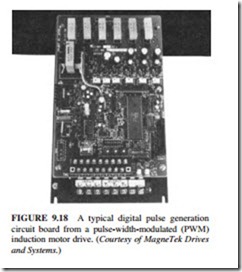PULSE CIRCUITS
Some of the devices listed require a pulse of current to their gating circuits to operate. Analog and digital techniques are used to produce voltage and current pulses. Analog methods rely on PNPN diodes which have discrete nonconducting and conducting regions in their voltage-current characteristics.
A voltage and current pulse is gener- ated by the transition from the conducting to the nonconducting region of the device. Relaxation oscillator is the name given to the circuit used to generate analog pulse.
Digital pulse generation circuits are com- monly used in modern solid-state motor drives. They use a microcomputer which executes a program stored in read-only memory (ROM). The program uses differ- ent inputs to generate pulses at the proper time. Common inputs that the program considers are the desired speed of the motor, actual speed of the motor, rate of acceleration or deceleration, and specified voltage and current limits. Figure 9.18 illustrates a typical digital pulse generation circuit board from a pulse-width-modulated induction motor drive. The following simple analog circuits are examples of some basic types of pulse-producing circuits.
